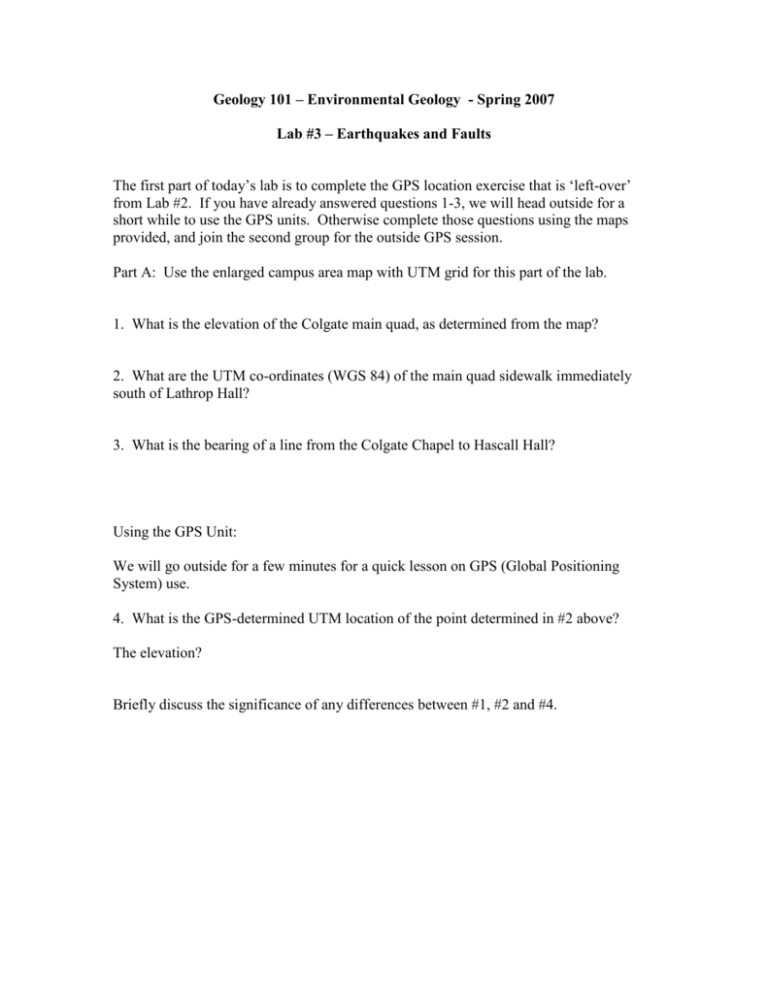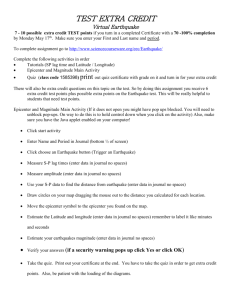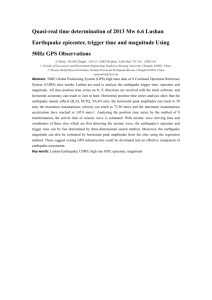Geology 101 – Environmental Geology
advertisement

Geology 101 – Environmental Geology - Spring 2007 Lab #3 – Earthquakes and Faults The first part of today’s lab is to complete the GPS location exercise that is ‘left-over’ from Lab #2. If you have already answered questions 1-3, we will head outside for a short while to use the GPS units. Otherwise complete those questions using the maps provided, and join the second group for the outside GPS session. Part A: Use the enlarged campus area map with UTM grid for this part of the lab. 1. What is the elevation of the Colgate main quad, as determined from the map? 2. What are the UTM co-ordinates (WGS 84) of the main quad sidewalk immediately south of Lathrop Hall? 3. What is the bearing of a line from the Colgate Chapel to Hascall Hall? Using the GPS Unit: We will go outside for a few minutes for a quick lesson on GPS (Global Positioning System) use. 4. What is the GPS-determined UTM location of the point determined in #2 above? The elevation? Briefly discuss the significance of any differences between #1, #2 and #4. Part B: Exercise using travel times to locate earthquake epicenter. As we discussed in class, seismographs record the first arrival of earthquake waves from distant events. The velocity of P-waves exceeds that of S-waves so we can use the difference in arrival time to determine the distance between the earthquake and the seismograph station. Knowing that distance for three stations, we can locate the earthquake source. Using the seismograms on the next page, calculate the time lag between the P-wave and S-wave arrival times for each of the stations. Record the data below: St. Louis: _______________ Bloomington:____________________ Minneapolis: _____________ Bowling Green: __________________ To determine the distance from the earthquake to each station based on the time lag between P and S arrivals, we need to know the average velocities of P and S waves and the effect this has on travel time. Average P wave velocity in the crust is 6.1 km/sec; average S wave velocity is 4.1 km/sec. This means that for each second of time since the earthquake, the P waves have traveled 2 km farther than the S waves. Another way of thinking about this is to calculate the time lag at some distance from the epicenter, say 100 km. P-waves travel 100 km in _______ seconds S-waves travel 100 km in _______ seconds Thus the time lag at a distance of 100 km from the epicenter (T100) is ________ seconds. For longer distances we can use a simple proportion equation to determine the distances based on the time lag: X Tx = 100km T100 Where X is the unknown distance in kilometers; Tx is the time lag for the distance X; T100 is the time lag at 100 km.. Using this relationship, calculate the distances from each of the stations to the earthquake epicenter: St. Louis(SLM): _______________ Bloomington (BLO):___________________ Minneapolis (MNM): _____________ Bowling Green (BGO):_________________ Use the map of the continental US on the following page, and a drawing compass or ruler to draw arcs of appropriate scaled length, and locate the earthquake epicenter. Part C: Earthquake research assignment using the USGS website Use the United States Geological Survey site – http://earthquake.usgs.gov/regional/neic/ to investigate recent worldwide earthquake events. Select a recent event (within the last 2 years) and write a short (250 words) description of the event which includes the following information: a. Location (include a map showing the epicenter and nearby geography) b. Magnitude and Intensity c. Damaging effects d. Type of fault e. Plate tectonic setting f. Influence of local geology on the distribution of damaging effects






